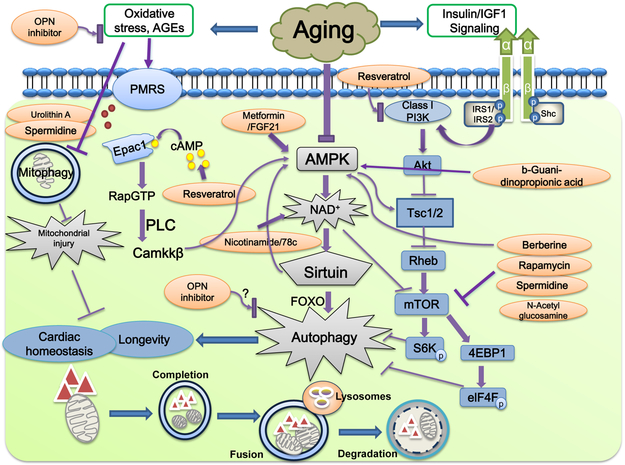Fig. 1:
Schematic diagram depicting dysregulation of autophagy in advanced aging and how various pharmacological interventions may intervene the autophagy signaling process. Aging is commonly associated with impaired autophagy and mitophagy. Two main regulatory signaling machineries involved in dysregulated autophagy are suppressed AMPK activation and elevated class I PI-3K/Akt signaling, resulting in overactivated mTOR signaling, autophagy failure and changes in longevity and cardiac homeostasis. Improved lifespan and cardiac function in aging may be achieved through activation of AMPK directly or NAD+-dependent sirtuins indirectly. Sirtuins in turn promote longevity through FOXO-dependent induction of stress response and autophagy. Some pharmacological anti-agents such as resveratrol may benefit longevity and cardiac aging through autophagy-independent mechanism such as cAMP accumulation, leading to phospholipase C (PLC)-mediated activation of CamKKβ. Rapamycin, spermidine and N-acetyl glucosamine are considered autophagy inducers to directly act on mTOR. Free radical accumulation and oxidative stress such as AGEs turn on multiple oxido-reductase enzymes in aging commonly known as plasma membrane redox system (PMRS) that regulates cellular redox homeostasis and mitochondrial integrity. Bottom panel displays the essential steps in autophagy including nucleation and elongation, completion, fusion between autophagosomes and lysosomes as well as lysosomal degradation. Abbreviations PMRS: plasma membrane redox system, IGF-1: insulin like growth factor-1, FOXO: Forkhead O transcriptional factor; IRS: Insulin receptor substrate; EPac1: exchange protein directly activated by cAMP; OPN: osteopontin; CamKKβ: Ca2+/calmodulin-dependent protein kinase kinase β; mTOR: mammalian target of Rapamycin, PI3K: Phosphatidylinositol 3-kinase.

